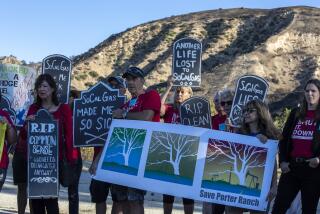Teapot Dome Oil Field Running Out of Steam as Resources Fade
- Share via
MIDWEST, Wyo. — Navy Lt. Doug Tunison’s command is 9,400 acres of sage grass and rock where antelope and mule deer graze beside slowly pumping oil rigs. He is more than 900 miles from the sea.
“The Navy doesn’t really understand what I’m doing out here,” he says.
Tunison, a petroleum engineer, keeps watch over Naval Petroleum Reserve No. 3, better known as Teapot Dome.
Last fall, Congress decreed that he will be the last in a long line of naval officers who have kept an eye on the oil field since a scandal rocked President Harding’s administration in 1922.
The Department of Energy will give up the oil field in 2003, when consultants estimate that it will be no longer profitable for the government.
Through the years, the officer’s job has evolved from naval watchdog to petroleum production manager.
Tunison performs his duties without the polished brass or working khakis of a naval officer. There is no military formality here. He usually looks like the field’s other 13 government workers, wearing a hard hat, khaki pants and dusty steel-toed boots.
Aside from rare visits from Navy or government officials, Tunison has only one military duty a year: the Navy ball. In Wyoming, mainly reserve officers attend.
Tunison’s tour, about 35 miles northeast of Casper in central Wyoming, ends in 15 months. He will be reassigned to work with construction contractors at naval bases.
“Any job in Europe would be nice,” he said.
About the same time, Department of Energy officials hope to submit legislation to sell Teapot Dome to a private company or a group that would open it to drilling research.
In 1981, just after the second oil shock, production at Teapot Dome peaked at 5,000 barrels a day. But now, 83 years after it opened, production has slipped to about 800 barrels a day, and experts expect it to produce only about 150 barrels a day in five years.
In contrast, Wyoming’s top-producing oil fields collect up to 4,000 barrels a day.
The surface, bordered by slanting rock ridges, is littered with abandoned wells and equipment from the field’s heyday.
Time has even taken its toll on a nearby rock formation that looked like a teapot to early prospectors. A 1962 windstorm broke off the “spout.”
But the dome, underground layers of rock shaped liked an upside-down bowl, is better known for its place in history than its oil.
The government took control in 1915 when President Wilson set it aside in case the Navy needed oil for battleships, destroyers and other warships as World War I approached.
The Navy never used Teapot Dome’s oil directly. After the war, the field was transferred to the Department of the Interior and oilmen pressed their claims on it.
From 1921 to 1922, Interior Secretary Albert Fall secretly leased the field to oilman Harry Sinclair without public bids as required by law. Fall resigned and was convicted for taking bribes from several oilmen, including Sinclair. He spent one year in prison.
Sinclair was acquitted, but was jailed 6 1/2 months for hiring detectives to monitor the jury.
Sinclair Oil Co., with the green dinosaur logo on gas station signs, remains the biggest buyer of Teapot Dome oil.
After the scandal, the Navy retook control of the field and most of its oil was undisturbed until the late 1970s, after the Naval Petroleum Reserves Act of 1976 required that it be developed and its crude sold directly to commercial markets.
“The history of why I’m here makes the job interesting,” Tunison said. “It’s pretty obscure.”
By 1992, the government realized that falling oil prices and rising production costs would make the field uneconomical. Still, it is expected to earn about $3 million in revenue this year.
With oil prices hovering between $14 and $15 a barrel, the prospect of finding a buyer for Teapot Dome may not be good.
“These are not attractive assets,” said David Lauciault, an oil and gas industry consultant for A.T. Kearney in Dallas. “By almost any measure, these assets are sub-par.”
Until 2003, Tunison and Department of Energy officials will try to find ways to cut costs and continue to make a profit.
“How do you get out of the business to get the most money for the taxpayers?” asked Clarke Turner, director of Naval Petroleum and Oil Shale Reserves in Colorado, Utah and Wyoming. “Congress doesn’t want us to lose money.”
The Department of Energy has offered options for the oil field:
The government could sell it, probably to a small independent producer, that would continue production of oil on a small scale.
Or, the government-run Rocky Mountain Oilfield Testing Center program could allow oil companies and universities to use it to test new drilling or extraction methods.
Turner has proposed that a group of universities and companies buy the program and the oil field to make the property a test center. The government plans to transfer the program to private groups by 2001 anyway.
Or, the Department of Interior, the state, or a private trust could purchase the land as a park or wildlife conservation area.
A final option would be to plug and abandon all the wells and sell the land for grazing.
“I can’t really see a definite path,” Tunison said.
More to Read
Sign up for Essential California
The most important California stories and recommendations in your inbox every morning.
You may occasionally receive promotional content from the Los Angeles Times.













